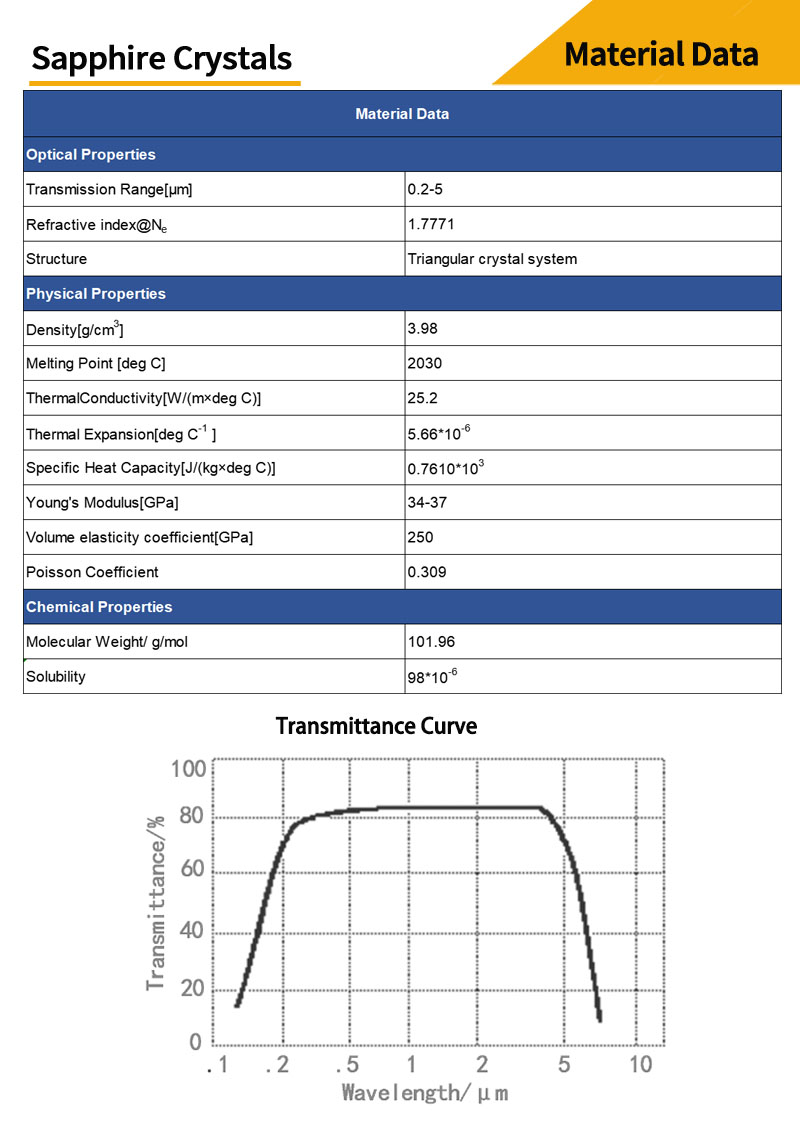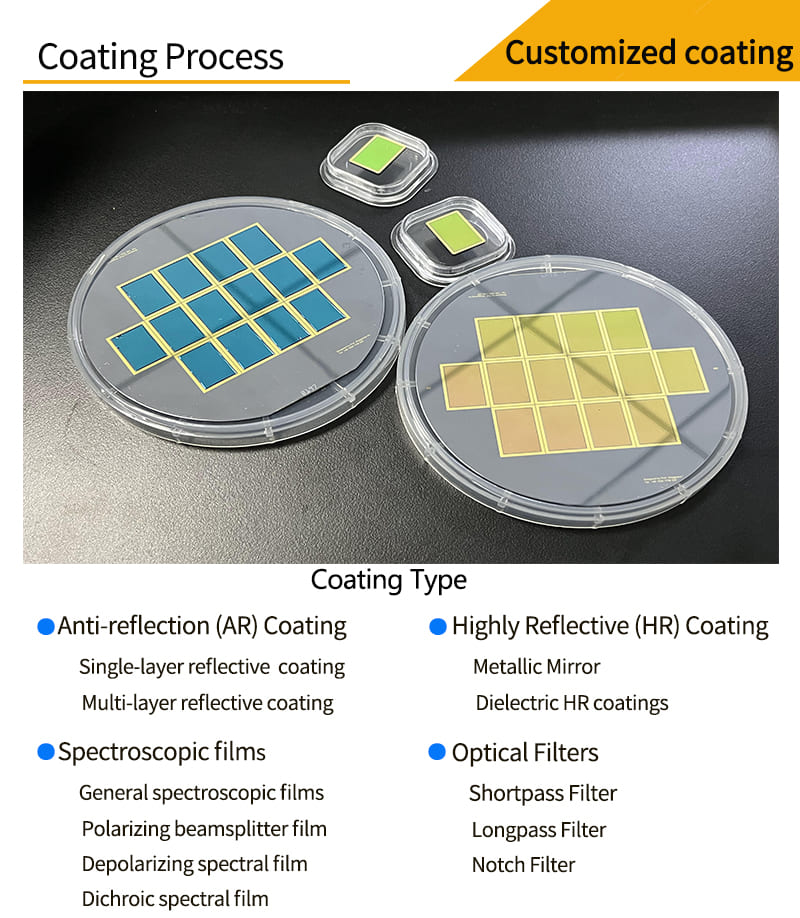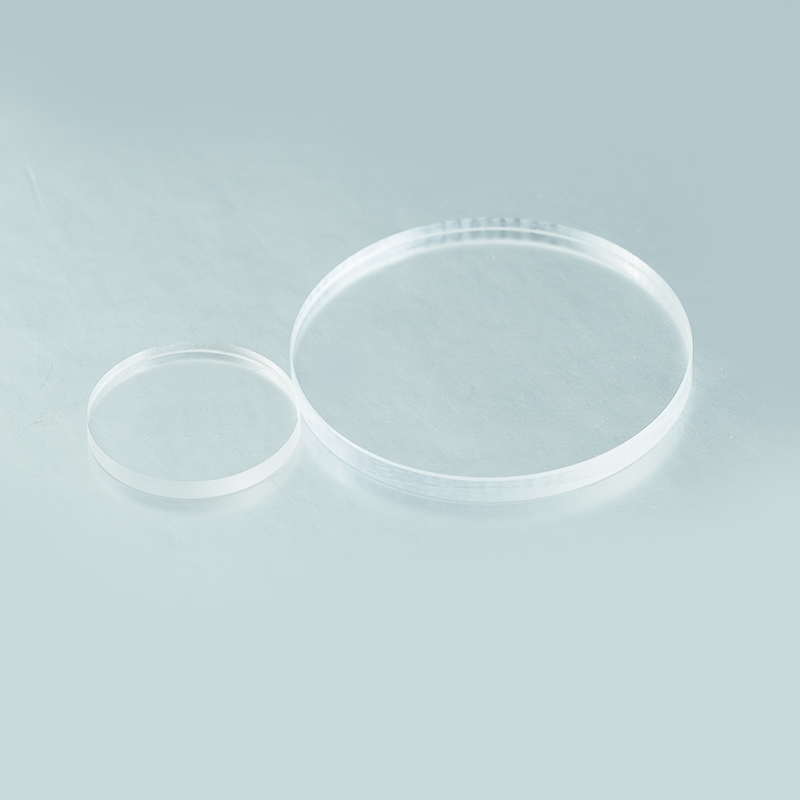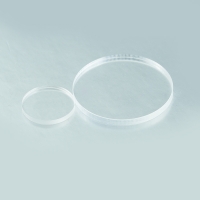Sapphire round windows
Product Introduction :
Sapphire windows have high surface hardness, high thermal conductivity and chemical resistance. The transmission wavelength range of sapphire windows is 0.2-5 μm, covering the ultraviolet to the mid-infrared. Since the hardness of sapphire is second only to diamond, the thickness of sapphire windows made with enhanced light transmission is thinner than that of general high-dielectric windows. Sapphire windows are highly resistant to extreme temperature and pressure changes. Sapphire windows are often used as viewing windows to look inside vacuum cavities or cavities containing high-temperature plasma.
Our Company can provide sapphire round windows with diameters from 2-300mm. UM OPTICS has advanced processing equipment and advanced testing equipment, including ultra-precision single point diamond turning, profilometer, ZYGO planar/spherical interferometer, Fuji interferometer, spectrophotometer, eccentric instrument, goniometer, etc., to ensure the final product quality of sapphire windows.
Coating selection:
MgF2, UV-AR,UV-VIS ,VIS-EXT, VIS-NIR, NIR I, NIR II, Telecom-NIR,SWIR ,SWIR ,YAG-BBAR.
Sapphire has a high surface hardness, high thermal conductivity, high dielectric constant and resistance to chemical acids and bases. The hardness of sapphire is second only to diamond.

Sapphire is a single crystal of aluminum trioxide (Al2O3) with good chemical, mechanical and optical properties: it is resistant to strong acids and can be used in corrosive environments; the surface is resistant to scratching and abrasion.

Coating refers to coating a transparent electrolyte film or metal film on the surface of the substrate material by physical or chemical methods. The purpose is to change the reflection and transmission characteristics of the material surface to reduce or increase the reflection, beam splitting, color separation, light filtering, polarization and other requirements.We can provide various optical coatings such as anti-reflective films, high-reflective films, spectral films, and metallic films. Broadband anti-reflective films are available for UV, visible, NIR and mid-infrared wavelengths.

Sapphire is a single crystal of aluminum trioxide (Al2O3) with good chemical, mechanical and optical properties: it is resistant to strong acids and can be used in corrosive environments; the surface is resistant to scratches and abrasions. Sapphire windows are often used as viewing windows to look inside vacuum cavities or cavities containing high-temperature plasma.

●N-BK7
N-BK7 is the most commonly used optical glass for processing high quality optical components,, with excellent transmittance from visible to near-infrared wavelengths(350-2000nm), and has a wide range of applications in telescopes, lasers and other fields. N-BK7 is generally chosen when the additional benefits of UV fused silica (very good transmittance and low coefficient of thermal expansion in the UV band) are not required.
●UV fused silica
UV fused silica has a high transmission from the UV to NIR (185-2100nm). In addition, UV fused silica has better uniformity and lower coefficient of thermal expansion than H-K9L (N-BK7), making it particularly suitable for high power laser and imaging applications.
●Calcium fluoride
Due to its high transmittance and low refractive index within a wavelength of 180nm-8um, calcium fluoride is often used as windows and lenses in spectrometers and thermal imaging systems. In addition, it has good applications in excimer lasers because of its high laser damage threshold.
●Barium fluoride
Barium fluoride have high transmittance from the 200nm-11um and they are resistant to stronger high-energy radiation. At the same time, barium fluoride has excellent scintillation properties and can be made into various infrared and ultraviolet optical components. However, the disadvantage of barium fluoride is that it is less resistant to water. When exposed to water, the performance degrades significantly at 500℃, but it can be used for applications up to 800℃ in a dry environment. At the same time, barium fluoride has excellent scintillation properties and can be made into various infrared and ultraviolet optical components.It should be noted that when handling barium fluoride material, gloves must be worn at all times and hands must be washed thoroughly after handling.
●Magnesium fluoride
Magnesium fluoride is ideal for applications in the wavelength range of 200nm-6um. Compared to other materials, magnesium fluoride is particularly durable in the deep UV and far IR wavelength ranges. Magnesium fluoride is a powerful material for resistance to chemical corrosion, laser damage, mechanical shock and thermal shock. It is harder than calcium fluoride crystals, but relatively soft compared to fused silica, and has a slight hydrolysis. It has a Nucleus hardness of 415 and a refractive index of 1.38.
●Zinc selenide
Zinc selenide has high transmittance in the 600nm-16um and is commonly used in thermal imaging, infrared imaging, and medical systems. Also, due to its low absorption, zinc selenide is particularly suitable for use in high-power CO2 lasers. It should be noted that zinc selenide is a relatively soft material (Nucleus hardness 120) and is easily scratched, so it is not recommended for use in harsh environments. Extra care should be taken when holding, and cleaning, pinching or wiping with even force, and it is best to wear gloves or rubber finger covers to prevent tarnishing. Cannot be held with tweezers or other tools.
●Silicon
Silicon is suitable for use in the NIR band from 1.2-8um.Because of its low
density, silicon is particularly suitable in applications where weight
requirements are sensitive, especially in the 3-5um . Silicon has a Nucleus
hardness of 1150, which is harder than germanium and not as fragile as
germanium.It is not suitable for transmission applications in CO2 lasers
because of its strong absorption band at 9um.
●Germanium
Germanium is suitable for use in the near-infrared band of 2-16um and is well
suited for infrared lasers. Due to its high refractive index, minimal surface
curvature and low chromatic aberration, germanium does not usually require
correction in low power imaging systems. However, germanium is more
severely affected by temperature, and the transmittance decreases with
increasing temperature; therefore, it can only be applied below 100°C. The
density of germanium (5.33 g/cm³) is taken into account when designing
systems with strict weight requirements. Germanium lenses feature a
precision diamond lathe turned surface, a feature that makes them well suited
for a variety of infrared applications, including thermal imaging systems,
infrared beam splitters, telemetry, and in the forward-looking infrared (FLIR)
field.
●CVD ZnS
CVD ZnS is the only infrared optical material, other than diamond, that covers visible to long-wave infrared (LWIR), full wavelength and even microwave wavelengths, and is currently the most important LWIR window material. It can be used as windows and lenses for high-resolution thermal imaging systems, as well as for advanced military applications such as "tri-optical" windows and near-infrared laser/dual-color infrared composite windows.
































































































